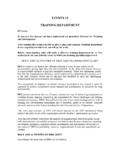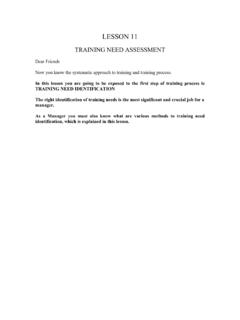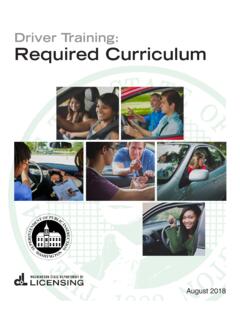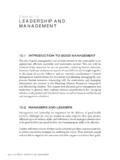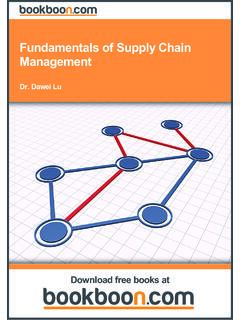Transcription of LESSON 10 APPROAHCES TO TRAINING - Management …
1 LESSON 10 APPROAHCES TO TRAINING Systematic approach to TRAINING Dear Friends, This LESSON is going to expose you towards systematic approach towards TRAINING . The steps in TRAINING process. After reading this LESSON you will be able to 1. Understand the systematic approach towards TRAINING 2. Explain various steps in TRAINING process 3. Apply the systematic TRAINING procedure for TRAINING function in your department THE TRAINING PROCEDURE One of the better personnel programmes to come out World War II was the TRAINING Within the Industry (TWI) programme of the War Manpower Commission. This was basically a supervisory TRAINING programme to make up for the shortage of civilian supervisory skills during the war.
2 One of the parts of this programme was the job instruction TRAINING course, which was concerned with how to teach? The TRAINING procedure discussed below is essentially an adoption of the job instruction TRAINING course, which has been proved to have a great value. The important steps in TRAINING procedure are discussed below: (a) Preparing the Instructor: The instructor must know both the job to be taught and how to teach it. The job must be divided into logical parts so thateach can be taught at a proper time without the trainee losing plan. For each part one should have in mind the desired technique of,instruction, that is, whether a particular point is best taught by illustration, demonstration or explanation.
3 A serious and committed instructor must: (i) know the job or subject he is attempting to teach, (ii) have the aptitude and abilities to teach, (iii) have willingness towards the profession, (iv) have a pleasing personality and capacity for leadership, (v) have the knowledge of teaching principles and methods, (vi) be a permanent student, in the sense that he should equip himself with the latest concepts .and knowledge. (b) Preparing the Trainee: As in interviewing, the first step in TRAINING is to attempt to place the trainee at ease. Most people are somewhat nervous when approaching an unfamiliar task. Though the instructor may have executed this TRAINING procedure, many times he or she never forgets its newness to the trainee.
4 The quality of empathy is a mark of the good instructor. (c) Getting Ready to Teach: This stage of the programme is class hour teaching involving the following activities: Planning the programme. - Preparing the instructor's outline. - Do not try to cover too much material. - Keep the session moving along logically. - Discuss each item in depth. - Repeat, but in different words. - Take the material from standardised texts when it is available. - When the standardised text is not available, develop the programme and course content based on group approach. Group consists of employer, skilled employees. supervisors, trade union leaders and others familiar with job requirements.
5 Group prepares teaching material.' - Teach about the standard for the trainee like quality, quantity, waste or scrap, ability to work without supervision, knowledge or procedure, safety rules, human relations etc. Remember your standard, before you teach. - Planning TRAINING Sessions 1. Every LESSON should be planned. 2. Know how many and what kind of students you are teaching? 3. Layout the subject-matter. 4. Select the best method of instruction. 5. Decide what the students need in the way of preparation. 6. Make plans to capture and maintain student interest 7. Plan summary of points to be emphasised. 8. Plan for using of TRAINING aids, if any. 9. Have a rehearsal of the LESSON ?
6 10. Plan for examination questions. - - Take periodical progress of the trainees, and application into account. d) Presenting the Operation: There are various alternative ways of presenting the operation, viz., explanation, demonstration etc. An instructor mostly uses these methods of explanation. In addition .one may illustrate various points through the use of pictures, charts, diagrams and other TRAINING aids Exhibit presents TRAINING aids. Demonstration is an excellent device when the job is essentially physical in nature. The following sequence is a favorite with some instructors: (i) Explain the sequence of the entire job.
7 (ii) Do the job step-by-step according to the procedure. (iii) Explain the step that he is performing (iv) Have the trainee explain the entire job. (e) Try Out the Trainee's Performance: As a continuation of the presentation sequence given above, the trainee should be asked to start the job or operative procedure. Some instructors prefer that the trainee explains each step before doing it, particularly if the operation involves any danger. The trainee, through repetitive practice, will acquire more skill. TRAINING Aids Films, Slides, Projectors, Movies, Stills. Charts, Graphs, Rash Cards, Rannel Boards, Pictograms.
8 Pamphlets, Brochures, Handbooks, Manuals. Libraries and'Reading Rooms. Teaching Machines, Closed Circuit lV. Exhibits, Posters and Displays. Notice Boards, Bulletin Boards, Enlarged Drawings. Cartoons, Comic Books, Books. (f) Follow-up: The final step in most TRAINING procedures is that of follow-up. When people are involved in any problem or procedure, it is unwise to assume that things are always constant. Follow-up can be adopted to a variable reinforcement schedule as suggested in the discussion of learning principles. The follow-up system should provide feed-back on TRAINING effectiveness and on total value of TRAINING system as shown in below: TRAINING programme Employees Performance present job Employee identified for TRAINING Measurement of actual job performanceEmployees for new assignment Employees after TRAINING Measurement of TRAINING performance Suitability for new assignment 2 TRTRTRAINING PROCEDURE Update the programme Evaluate the results Try out the trainees performanceGain the acceptance of the programmePresent the operations Implementing TRAINING programme Get ready to teachPrepare the trainee Prepare the instructor Design TRAINING content teaching methods and mediaCost Benefit analysis Design the TRAINING needsIdentify the TRAINING needs
9 Evaluate the trainee Job and organization analysis 000, COMMER CIAL SOLUTIONS TRAINING & Development (214) 503 - 1706 Program Input PROGRAM OUTPUT IMPLEMENT TRAINING PROGRAM DESIGN TRAINING METHODS & APPROPRIATEMEDIADETERMINE TRAINING CONTENTS SPECIFY TRAINING OBJECTIVES IDENTIFY TRAINING REQUIREMENTS TRAINING PROCESS FLOW CHART HIGH YIELD TRAINING CHECKLIST Before TRAINING 1. What Are The Specific, Immediate & Important Competencies You Seek? (What Must You Know & Be Able To Do That Warrant The TRAINING Investment?) 2. Is A TRAINING Session The Best Way To Develop The Needed Competencies? (Consider A Book, Coaching, Mentoring, A Video On The Subject, etc.)
10 3. Does Your Boss Agree With The Need For The Targeted Competencies & Is She Willing To Help You Follow Thru? (Will She Prioritize & Hold You Accountable For Each New Competency?) 4. Can You Identify A TRAINING Program With TRAINING Objectives That Match Your Learning Objectives? 5. Will The Content And Activities Described In The Program Agenda Clearly & Convincingly Produce The Targeted Learning Objectives? 6. Is There Assigned Or Recommended Pre-Work To Improve Program Effectiveness Or Efficiency? 7. Have You Prepared Need-Specific Work Situations To Work On In Class? During TRAINING 1. Did You Arrive Early Enough To Meet The Instructor And Discuss Your Learning Expectations?
